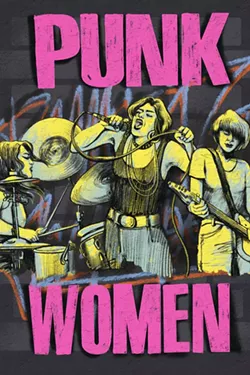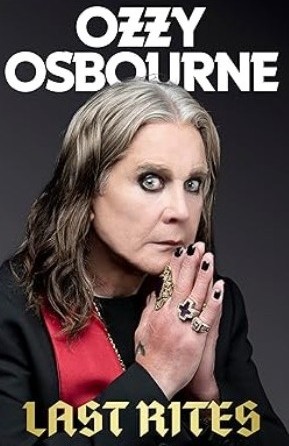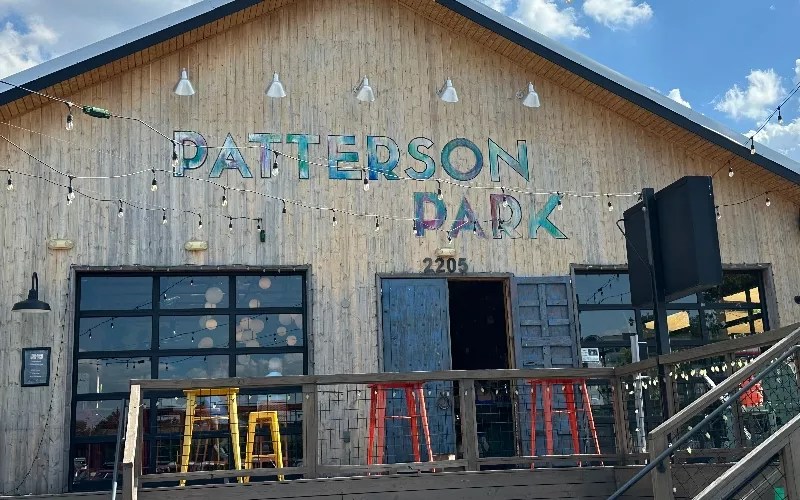Things to Do: Read Punk Women by David Ensminger and Go to Cactus Music Booksigning
Asked to name a punk rock musician, most people would by rote memory spit out the names of the members of the Ramones, Clash, or Sex Pistols. Those with a deeper aural reservoir might cough up the Dead Kennedys, Buzzcocks, Damned, or Misfits.
That would be—in earthy parlance, given the gender makeup of those groups—a real sausage party.
But the presence, persistence, and contributions of women to punk rock since its genesis in the mid-1970s has been lesser known and recognized. It was something that really bothered author and musician David Ensminger, so he decided to do something about it.
And the end result is his book Punk Women: 40 Years of Musicians Who Built Punk Rock (304 pp., $19.99, Microcosm Publishing).
It’s a revised and expanded new edition that includes the entirety of Ensminger’s previous two DIY books on the subject, plus new material. Its many photos and illustrations show performers then and now, gig flyers, and record covers. And it’s all laid out graphically to resemble those old school, ramshackle ‘zines that Ensminger so adores (he once even had his own—Left of the Dial).
David Ensminger will sign and discuss Punk Women with a panel group of musicians featured in the book and (possibly!) some live music at Cactus Records on September 27.
“When I was doing Left of the Dial, I noticed a lot of [punk] bands I was talking to had female members. So, it dawned on me that not enough attention had been given to women across the punk spectrum, I’m not talking about just Riot Grrrls,” Ensminger says. Noting the musical/social movement that started in the early 2000s and how the term has become sort of a catchall to describe any female rocker.
“That took up all the oxygen in the room. But the women I came up with were punk rockers and rock and rollers period. I mean, Bikini Kill is interesting and powerful, but a lot of women got left out of that equation.”
Punk Women pulls together a lot of Ensminger’s archival writing, but also new material. And it runs the gamut from feature prose interviews to Q&A, his own observations, and even transcripts of subjects talking directly. The author calls it “the Wal-Mart” of approach of narrative styles and music journalism convention.
And those subjects include both familiar punk names (Patti Smith, Kate Pierson of the B-52s, Deborah Harry of Blondie, Poison Ivy from the Cramps, Lydia Lunch) to deep-dive bands and performers. Ensminger says the layout and structure encourages the reader to dip in and out of it rather than a straight read through.
“I try to touch enough different types of music from garage and hardcore to new wave and punk rock for a [general] reader. I want people to just parachute into the book and find something,” he says.
Houston punk women are covered, and especially mydolls. Formed in 1978, the original quartet—three of whom are women—still perform today. Ensminger is close to them, and they’ll be guests this month on his KPFT 90.1 radio program, The Sonic Reducer Show, which airs on Thursdays from 8-9 p.m.
“They were there from ground zero in Houston punk with the Hates and Legionaire’s Disease. Everybody knows them now. They’ve played the Museum of Fine Arts and have a collection at the University of Houston,” he says.
Ensminger also notes how the introduction of the hardcore movement starting around ’81 or ‘82 into punk affected outlook of gender on the genre.
“It became more brutal and boy-focused and crowded out the girls. My sister is seven years older than me and my brother is ten. They would be bringing home records, so we loved the Cramps and Blondie. I can’t believe that anybody is not thinking about women in punk all the time. It’s all one big umbrella.”
Punk Women includes a lot of more contemporary photos of the female musicians, not just freezing them in the ‘70s and ‘80s.
“Women musicians tell me as they age—and I think it’s true with actresses and writers too—that they begin to feel invisible. Because they’re crowded out by younger generations. We have to bring them back into focus and the light and appreciate that they have this resilience and persistence. And that’s what their stories embody,” Ensminger offers.
“What they’re doing today may not be a photocopy of what they did in 1978. But they’re still bringing an inventiveness and stylistic challenge to us. It may be slower or more philosophical with less vitriol and aggression,” he adds.
“I want people to open this book and see women in their fifties and sixties and seventies still doing this.” He adds that in a youth dominated culture, there is absolutely a place for more seasoned rockers with a bit of wisdom and insight.
Ultimately, Ensminger says he’s inspired also by the women in his own life, including his wife, his sister, and even his former wife, all involved to some degree in punk rock music.
In fact, at the end of Punk Women, Ensminger pays special heartfelt tribute to Julie, his wife of 28 years, who calls his “constant lover, companion, sidekick, and partner in creative crimes.” He admits that that first term, one that the couple uses frequently, subjects them to some good-natured ribbing from friends.
“We’re very affectionate, so we throw around that term every day!” he laughs. “It drives some people crazy!”
David Ensminger and guests will sign and discuss Punk Women at 1 p.m. on Saturday, September 27, at Cactus Music, 2110 Portsmouth. For information, call 713-526-9272 or visit CactusMusicTX.com.

Reign Bowers is an outdoor enthusiast, adventure seeker, and storyteller passionate about exploring nature’s wonders. As the creator of SuperheroineLinks.com, Reign shares inspiring stories, practical tips, and expert insights to empower others—especially women—to embrace the great outdoors with confidence.









Post Comment